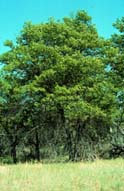
 |
Hill's oak (Quercus ellipsoidalis) |
What is
a Tree?
Trees
are typically defined as woody, single-stemmed, self-supporting, perennial
plants at least 15 feet tall at maturity and at least 3 inches in diameter,
with more or less recognizable crowns of foliage.
Some references point out the differences between conifers and deciduous trees. The main stem dominates the growth of the secondary (lateral) branches in the conifers. In deciduous trees, secondary branches are as important as the main trunk. They grow as the trunk forks to produce a more rounded crown.
Woody
plants that are not trees
Shrubs differ from trees by virtue of their height (trees are taller than 12 to 15 feet) and the fact that shrubs produce multiple stems closer to the base of the plant. The distinction between shrub and tree, however, is not always clear because a few shrubs can grow to heights typical of trees. Some common Illinois shrubs are: rough-leaved dogwood, hydrangea, smooth and staghorn sumac, American elderberry, buttonbush, American bladdernut, western snowberry, coralberry, Canada yew, and prickly ash.
Vines are also woody, single-stemmed plants, but their stems are not able to support the upright growth habit of trees. Instead, vines use other plants to support their vertical growth. Vines common to Illinois forests include poison ivy (Toxicodendron radicans), Virginia creeper (Parthenocissus quinquefolia), and several varieties of grape (Vitis species).
Why
are trees so important?
A great
emphasis is placed on trees in this Web module. For each forest type, for
example, there is a tree list with accompanying descriptions and herbarium sheets. Panoramas of forest types feature -hotspots- that link to individual tree descriptions.
This emphasis on trees reflects their ecological, biological, and cultural importance. Also, trees are critical to the classification of forests. Trees represent some of the oldest living organisms on the planet. For example, bristlecone pines, sequoias, and cypress are all long-lived species of trees. Trees were instrumental in the development and support of civilizations. They form important links in the earth's geological, chemical, and hydrological cycles by:
- Taking in CO2 and releasing oxygen;
- Releasing carbon and mineral elements such as nitrogen and phosphorus (important in plant growth) as they decay;
- Absorbing moisture for growth and releasing it as vapor through transpiration;
- Preventing erosion by reducing the force of rainfall at the soil surface and by intercepting and absorbing water, rather than allowing it to run off directly;
- Harboring a diversity of wildlife;
- Acting as windbreaks;
- Providing us with shade and beauty on a largely agricultural and urban landscape.
|
|
Copyright © 2000 Illinois State Museum